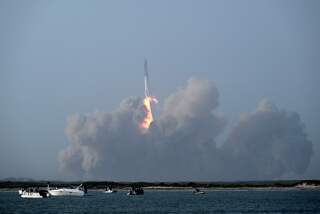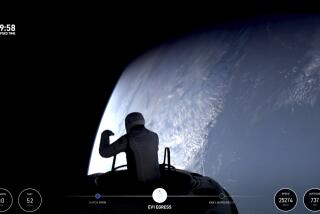Virgin Galactic spaceship reaches new heights in supersonic flight
MOJAVE, Calif. -- Virgin Galactic, British billionaire Richard Branson’s commercial space venture, reached its highest altitude yet Friday in a supersonic rocket plane that’s set to carry paying customers into sub-orbit later this year.
The company’s SpaceShipTwo blasted through the sound barrier and sped to Mach 1.4, climbing to 71,000 feet in its first powered test flight of the year.
The flight, the program’s third rocket-powered test flight, is the latest milestone in Virgin Galactic’s goal to take dozens of people into space multiple times each day.
The test flight took place shortly after sunrise Friday beginning on the desert runway at Mojave Air and Space Port, about 100 miles northeast of Los Angeles. During the test, SpaceShipTwo was taken to about 46,000 feet by a carrier aircraft and dropped like a bomb.
After a short free fall, test pilots Dave Mackay and Mark Stucky engaged the hybrid rocket motor, powered by nitrous oxide and a rubber compound, for about 16 seconds, at which point SpaceShipTwo accelerated to Mach 1.4.
Mackay, who left his job as an airline captain at Virgin Atlantic to become chief pilot for the space company, was at the controls. It was his first powered flight.
“To be behind the controls and fly it as the rocket ignited is something I will never forget,” he said. “She flew brilliantly.”
The two pilots tested the spaceship’s reaction control system, which will allow it to maneuver in space, and a newly installed thermal protection coating on the vehicle’s tail booms. All of the flight objectives were successfully completed, the company said.
The idea of Virgin Galactic routinely taking passengers into space this way was developed by retired maverick aerospace engineer Burt Rutan and his Mojave company, Scaled Composites.
Until now, astronauts have reached space packed tight in a capsule or shuttle attached to a high-powered rocket.
Instead, Virgin Galactic will use a WhiteKnightTwo carrier aircraft that will fly with the reusable SpaceShipTwo rocket plane under its wing to 50,000 feet, where the spaceship will separate and blast off.
When the rocket motor engages, it will power the spaceship to nearly 2,500 mph and take the pilot -- and up to six passengers -- to the edge of space, or more than 60 miles above the Earth’s surface.
Once they reach that suborbital altitude, passengers will experience weightlessness and see the curvature of the Earth. Then they will reenter the atmosphere and glide back to the runway. The price for the experience: $250,000.
If testing goes well, Virgin Galactic hopes to make its first passenger flight sometime this year from Spaceport America in New Mexico, where the company plans to conduct routine operations. The company said it has taken about 680 reservations for the ride.
The WhiteKnightTwo carrier aircraft, which resembles a flying catamaran because it has two fuselages, and SpaceShipTwo are still in the midst of a test-flight program that will continue in the Mojave until Virgin Galactic believes it can begin commercial operations.
Virgin Galactic’s commercial space launch system is based on Rutan’s SpaceShipOne, the world’s first private manned spaceship, which successfully flew a test pilot to space and back three times during 2004 to win a $10-million X-Prize purse.
The prize-winning spacecraft caught the eye of Branson, who wanted to work with Rutan on a much bigger rocket ship that could send not only a pilot into space but also fare-paying passengers.
The enterprise was shrouded in secrecy for years. Then in 2007, during a test of the spaceship’s propulsion system, an explosion killed three workers and injured three others. The blast exposed the secret project and reminded the public of the risks of rocketry.
The project continued and Branson has since built a 68,000-square-foot facility at the space port for a joint venture, called Spaceship Co., to mass-produce its rocket ship and carrier aircraft. It was one of the first aircraft assembly plants to be built in the region in decades.
A crowd of about 100 employees and airport officials gathered along the windswept flight line to watch Friday’s test flight. Among the crowd was Virgin Galactic Chief Executive George Whitesides.
“It looked like a beautiful flight,” he said. “With every flight, we’re getting a step closer to commercial service.”
ALSO:
Airbus names new chairman, CEO for U.S. unit
Drone giant California loses bids for federal testing sites
How I Made It: Wanda M. Austin, president and CEO of Aerospace
More to Read
Inside the business of entertainment
The Wide Shot brings you news, analysis and insights on everything from streaming wars to production — and what it all means for the future.
You may occasionally receive promotional content from the Los Angeles Times.











